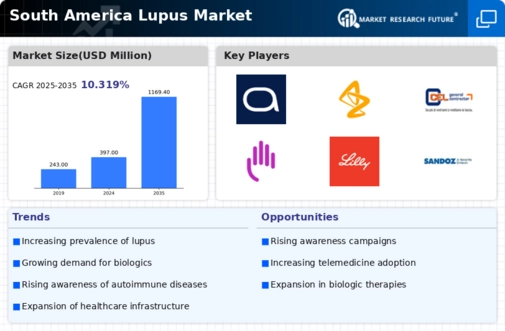Increasing Incidence of Lupus
The rising incidence of lupus in South America is a critical driver for the lupus market. Recent studies indicate that the prevalence of lupus in certain regions has increased by approximately 20% over the last decade. This trend is likely attributed to a combination of genetic, environmental, and lifestyle factors. As more individuals are diagnosed, the demand for effective treatments and management options intensifies. The lupus market is responding by expanding research initiatives and developing new therapies tailored to the unique needs of the South American population. This growing patient base not only drives revenue for pharmaceutical companies but also encourages healthcare providers to enhance their diagnostic and treatment capabilities.
Rising Healthcare Expenditure
The increase in healthcare expenditure across South America is a significant driver for the lupus market. As economies grow, governments and private sectors are investing more in healthcare infrastructure and services. Reports indicate that healthcare spending in the region has risen by 5% annually, with a notable portion allocated to chronic disease management, including lupus. This trend is likely to enhance access to treatments and improve the overall quality of care for lupus patients. Consequently, the lupus market stands to benefit from this increased investment, as it may lead to a wider array of treatment options and better patient support services.
Growing Patient Advocacy Groups
The emergence and growth of patient advocacy groups in South America play a crucial role in the lupus market. These organizations are dedicated to raising awareness, providing education, and supporting research initiatives related to lupus. Their efforts have led to increased visibility of the disease, which is essential for driving policy changes and securing funding for research. Advocacy groups are also instrumental in connecting patients with healthcare providers and resources, thereby enhancing patient engagement in their own care. As these groups continue to expand their reach, they are likely to influence the lupus market positively, fostering a more supportive environment for patients and healthcare professionals alike.
Government Initiatives and Funding
Government initiatives aimed at improving healthcare access and funding for lupus research are pivotal in shaping the lupus market in South America. Various countries in the region have allocated increased budgets for autoimmune disease research, with some governments investing over $10 million annually. These funds are directed towards developing new treatment protocols and enhancing patient care services. Additionally, public health campaigns are being launched to raise awareness about lupus, which is expected to lead to earlier diagnosis and treatment. Such initiatives not only bolster the lupus market but also foster collaboration between public health entities and private sector stakeholders, creating a more robust healthcare ecosystem.
Advancements in Diagnostic Technologies
The lupus market is experiencing a transformation due to advancements in diagnostic technologies. Innovative tools and techniques, such as biomarker identification and genetic testing, are becoming more accessible in South America. These advancements facilitate earlier and more accurate diagnoses, which is crucial for effective disease management. The market for diagnostic tests is projected to grow by approximately 15% annually, reflecting the increasing demand for precise and timely lupus detection. As healthcare providers adopt these technologies, the lupus market is likely to expand, leading to improved patient outcomes and a more informed patient population.

















Leave a Comment